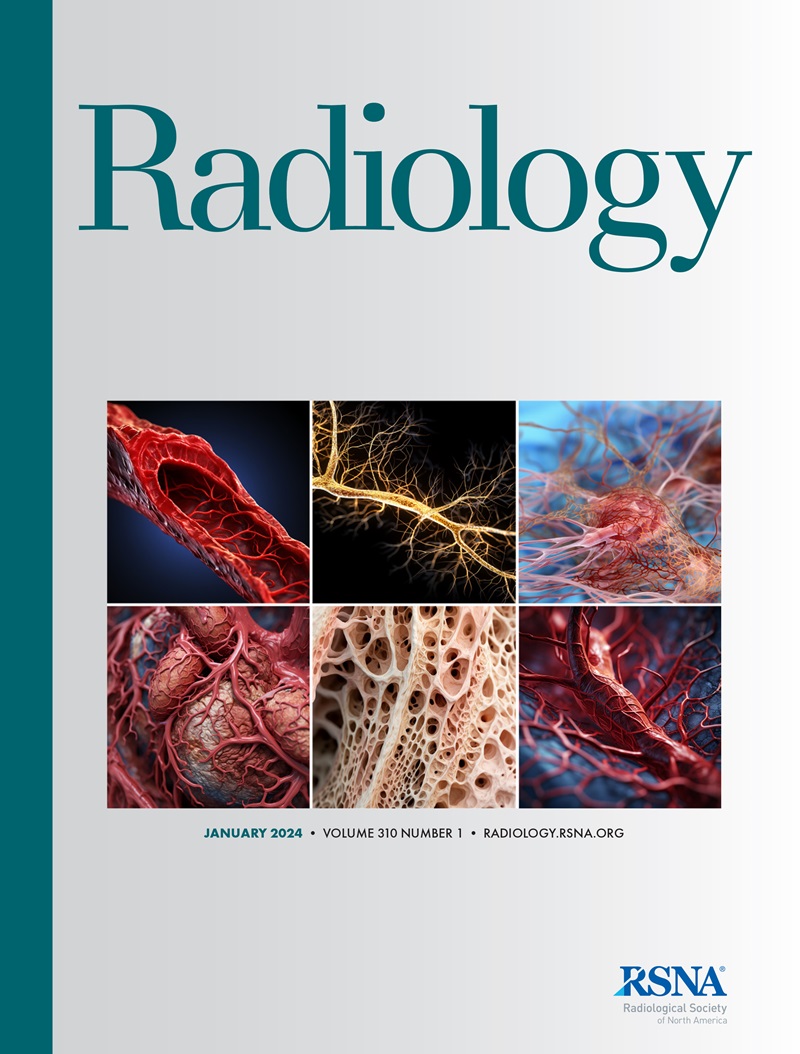Hormonal Regulation of Background Parenchymal Enhancement at Contrast-enhanced Mammography.
IF 12.1
1区 医学
Q1 RADIOLOGY, NUCLEAR MEDICINE & MEDICAL IMAGING
Noam Nissan, Varadan Sevilimedu, Jill Gluskin, Yuki Arita, Delia M Keating, Donna D'Alessio, Hila Fruchtman-Brot, R Elena Ochoa-Albiztegui, Janice S Sung, Maxine S Jochelson
下载PDF
{"title":"Hormonal Regulation of Background Parenchymal Enhancement at Contrast-enhanced Mammography.","authors":"Noam Nissan, Varadan Sevilimedu, Jill Gluskin, Yuki Arita, Delia M Keating, Donna D'Alessio, Hila Fruchtman-Brot, R Elena Ochoa-Albiztegui, Janice S Sung, Maxine S Jochelson","doi":"10.1148/radiol.241158","DOIUrl":null,"url":null,"abstract":"<p><p>Background Background parenchymal enhancement (BPE) is an important diagnostic and prognostic imaging biomarker. Although hormonal regulation of BPE at breast MRI has been investigated, information regarding hormonal regulation of BPE at contrast-enhanced mammography (CEM) remains scarce. Purpose To investigate how BPE at CEM changes across various short- and long-term physiologic and pharmacologic hormonal effects, including menopausal status, lactation, hormone replacement therapy (HRT), and tamoxifen therapy and its cessation. Materials and Methods This retrospective study included CEM examinations performed between December 2012 and January 2024. A computational search was performed to identify CEMs performed in patients with various hormonal statuses and several subgroups of patients were identified, including premenopausal, postmenopausal, lactating, HRT, and tamoxifen subgroups. For patients who received tamoxifen therapy, the first follow-up image at treatment cessation was included, when available. The four ordinal BPE grades, ranging from minimal to marked, as reported in the official radiologic reports were used for analysis. Subgroup comparisons were performed using the Kruskal-Wallis rank sum test and χ<sup>2</sup> test or Fisher exact test. Results A total of 507 female patients (mean age, 49.8 years ± 10.8 [SD]; range, 25-75 years) were included. Premenopausal patients (<i>n</i> = 200) exhibited higher BPE compared with postmenopausal patients (<i>n</i> = 200) (median grade, 1.0 [IQR, 0-2.0] vs 0 [IQR, 0-1.0]; <i>P</i> < .001). Lactating patients (<i>n</i> = 16) exhibited higher BPE (median grade, 3.0; IQR, 2.0-3.0) compared with nonlactating controls (median grade, 1.0; IQR, 0-2.0; <i>P</i> < .001). Patients receiving HRT (<i>n</i> = 14) exhibited higher BPE (median grade, 1.5; IQR, 0-3.0) compared with postmenopausal controls (median grade, 0; IQR, 0-1.0; <i>P</i> < .001). Patients receiving tamoxifen therapy (<i>n</i> = 77) exhibited lower BPE (median grade, 1.0; IQR, 0-2.0) compared with nontreated control patients (9% of patients with high BPE vs 31% for controls, <i>P</i> < .001) and increased BPE (median grade, 2.0; IQR, 1.5-2.5; <i>P</i> = .003) at the cessation of tamoxifen therapy. Conclusion Hormonal effects, including menopausal status, lactation, HRT, and tamoxifen therapy, influenced the degree of BPE at CEM. © RSNA, 2025 <i>Supplemental material is available for this article.</i> See also the editorial by Slanetz in this issue.</p>","PeriodicalId":20896,"journal":{"name":"Radiology","volume":"314 2","pages":"e241158"},"PeriodicalIF":12.1000,"publicationDate":"2025-02-01","publicationTypes":"Journal Article","fieldsOfStudy":null,"isOpenAccess":false,"openAccessPdf":"https://www.ncbi.nlm.nih.gov/pmc/articles/PMC11868820/pdf/","citationCount":"0","resultStr":null,"platform":"Semanticscholar","paperid":null,"PeriodicalName":"Radiology","FirstCategoryId":"3","ListUrlMain":"https://doi.org/10.1148/radiol.241158","RegionNum":1,"RegionCategory":"医学","ArticlePicture":[],"TitleCN":null,"AbstractTextCN":null,"PMCID":null,"EPubDate":"","PubModel":"","JCR":"Q1","JCRName":"RADIOLOGY, NUCLEAR MEDICINE & MEDICAL IMAGING","Score":null,"Total":0}
引用次数: 0
引用
批量引用
Abstract
Background Background parenchymal enhancement (BPE) is an important diagnostic and prognostic imaging biomarker. Although hormonal regulation of BPE at breast MRI has been investigated, information regarding hormonal regulation of BPE at contrast-enhanced mammography (CEM) remains scarce. Purpose To investigate how BPE at CEM changes across various short- and long-term physiologic and pharmacologic hormonal effects, including menopausal status, lactation, hormone replacement therapy (HRT), and tamoxifen therapy and its cessation. Materials and Methods This retrospective study included CEM examinations performed between December 2012 and January 2024. A computational search was performed to identify CEMs performed in patients with various hormonal statuses and several subgroups of patients were identified, including premenopausal, postmenopausal, lactating, HRT, and tamoxifen subgroups. For patients who received tamoxifen therapy, the first follow-up image at treatment cessation was included, when available. The four ordinal BPE grades, ranging from minimal to marked, as reported in the official radiologic reports were used for analysis. Subgroup comparisons were performed using the Kruskal-Wallis rank sum test and χ2 test or Fisher exact test. Results A total of 507 female patients (mean age, 49.8 years ± 10.8 [SD]; range, 25-75 years) were included. Premenopausal patients (n = 200) exhibited higher BPE compared with postmenopausal patients (n = 200) (median grade, 1.0 [IQR, 0-2.0] vs 0 [IQR, 0-1.0]; P < .001). Lactating patients (n = 16) exhibited higher BPE (median grade, 3.0; IQR, 2.0-3.0) compared with nonlactating controls (median grade, 1.0; IQR, 0-2.0; P < .001). Patients receiving HRT (n = 14) exhibited higher BPE (median grade, 1.5; IQR, 0-3.0) compared with postmenopausal controls (median grade, 0; IQR, 0-1.0; P < .001). Patients receiving tamoxifen therapy (n = 77) exhibited lower BPE (median grade, 1.0; IQR, 0-2.0) compared with nontreated control patients (9% of patients with high BPE vs 31% for controls, P < .001) and increased BPE (median grade, 2.0; IQR, 1.5-2.5; P = .003) at the cessation of tamoxifen therapy. Conclusion Hormonal effects, including menopausal status, lactation, HRT, and tamoxifen therapy, influenced the degree of BPE at CEM. © RSNA, 2025 Supplemental material is available for this article. See also the editorial by Slanetz in this issue.
对比增强乳房x线摄影中背景实质增强的激素调节。
背景实质增强(BPE)是一种重要的诊断和预后成像生物标志物。虽然已经研究了乳腺MRI对BPE的激素调节,但关于对比增强乳房x线摄影(CEM)对BPE的激素调节的信息仍然很少。目的研究CEM时BPE在各种短期和长期生理和药理学激素效应下的变化,包括绝经状态、哺乳期、激素替代治疗(HRT)、他莫昔芬治疗和停药。材料和方法本回顾性研究包括2012年12月至2024年1月期间进行的CEM检查。通过计算搜索来确定在不同激素状态的患者中进行的CEMs,并确定了几个患者亚组,包括绝经前、绝经后、哺乳期、HRT和他莫昔芬亚组。对于接受他莫昔芬治疗的患者,在治疗停止时的第一次随访图像包括在内,如果有的话。官方放射学报告中报告的四个有序BPE等级,从最小到标记,用于分析。亚组比较采用Kruskal-Wallis秩和检验、χ2检验或Fisher精确检验。结果共507例女性患者(平均年龄49.8岁±10.8 [SD];范围:25-75岁)。绝经前患者(n = 200)比绝经后患者(n = 200)表现出更高的BPE(中位分级,1.0 [IQR, 0-2.0] vs 0 [IQR, 0-1.0];P < 0.001)。哺乳期患者(n = 16)表现出更高的BPE(中位等级,3.0;IQR, 2.0-3.0)与非泌乳对照组相比(中位评分,1.0;差,0 - 2.0;P < 0.001)。接受HRT治疗的患者(n = 14)表现出更高的BPE(中位评分,1.5;IQR, 0-3.0)与绝经后对照组相比(中位评分,0;差,0 - 1.0;P < 0.001)。接受他莫昔芬治疗的患者(n = 77)表现出较低的BPE(中位等级,1.0;IQR, 0-2.0)与未治疗的对照组患者(9%的高BPE患者vs 31%的对照组,P < 0.001)和BPE增加(中位分级,2.0;差,1.5 - -2.5;P = 0.003)。结论激素作用,包括绝经状态、哺乳期、HRT和他莫昔芬治疗,影响CEM时BPE的程度。©RSNA, 2025本文可获得补充材料。参见Slanetz在本期的社论。
本文章由计算机程序翻译,如有差异,请以英文原文为准。

 求助内容:
求助内容: 应助结果提醒方式:
应助结果提醒方式:


